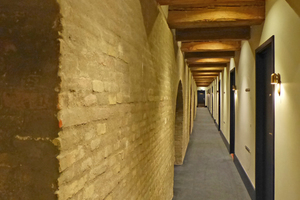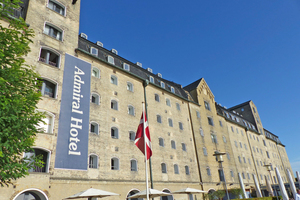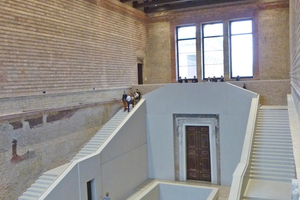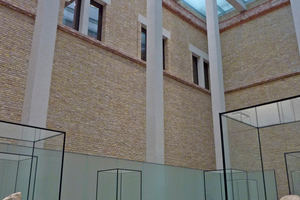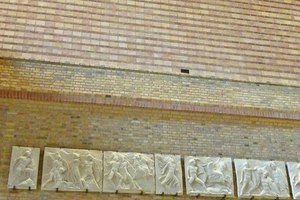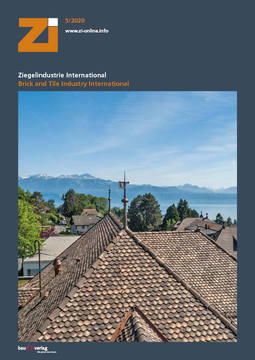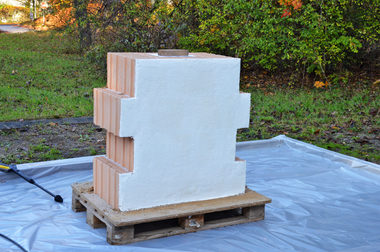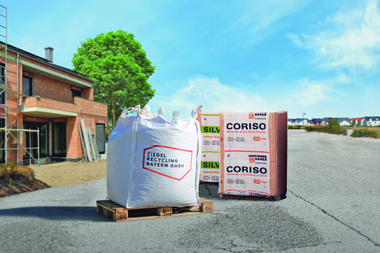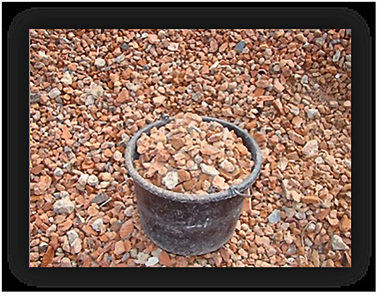Enhancing the longevity of ceramic building materials with the circular economy (CE)
The circular economy can be seen as a threat to industrial production. For: if building materials are to be recycled, will new materials have to be used at all? The article discusses how the future reuse of construction and demolition waste should and probably will be primarily as raw materials replacing virgin sand and other materials, not replacing new bricks. Manufacturers of clay bricks should take the initiative and start to incorporate “raw materials from waste” in their own production and tell everyone about it. Future construction must facilitate reuse by making it as easy as possible to sort out “pure” materials and obtain information about materials. This will change but not eliminate production of new materials.
1 Introduction
It has always been the hallmark of masonry that it lasts for centuries. “The essential quality of a building should be its solid nature. It is far too expensive and too impractical to have to renew it again and again”, said Marc-Antoine Laugier (1713-1769)
This quote embraces the essence of masonry, a material that has by its nature and quality challenged architects and builders to build for generations. This argument has been brought into question today by completely different trends. Namely, that you must design for an ultra-short life, because consumption and technology are constantly changing. Masonry buildings today are challenged both by the demand for fast construction and the lack of qualified craftsmen. However, quality has always cost money and will always be in demand.
The trends that particularly challenge masonry as a building material:
Firstly, it requires a large amount of energy to manufacture roofing tiles and bricks. In a comparison of energy consumption for manufacturing, which is termed “embodied energy”, directly per m2 of façade, then masonry performs poorly in competition with lightweight façade cladding materials such as metal, wood and the like
Secondly, the increased demands for energy performance of buildings, together with rapidly changing requirements for living space, have led to a need for expensive renovations of existing buildings. It has led some building designers to conclude that the future need for change will come so quickly that buildings should only be designed for a lifespan of 50 or even 20 years
But here it is forgotten that old buildings are often the most valuable. Even old brick-built industrial buildings are so attractive that they are converted into hotels, conference centres, etc.
Obviously, if the lifespan of a building is cut down to 50 or even 20 years, then the comparison between masonry and other building materials will highlight the embodied energy for the brick. At the same time, the short life of buildings is only relevant if all building materials can be recycled effectively.
How can the ceramic industry navigate these trends? Circular resource economics is no stranger to the masonry industry – tiles and bricks have always been reused. But today there are certain enhanced challenges – but also opportunities – that this article will address.
2 Reuse of bricks
The recycling of bricks could be seen as a threat to the brick industry, with each recycled brick replacing a new one. At the same time, one might fear that any recycled brick that does not meet the requirements for new bricks could damage the reputation of masonry in general. To start with, it is possible to use mostly the same test methods as for new bricks, and via spot sampling and statistical calculations that take the larger spread into consideration, to declare safe values for the compressive strength, density, water uptake, etc.
Special requirements must be met with regard to the demolition and control of any environmentally harmful substances that may have contaminated the masonry during its lifetime. This applies to all demolished building materials. In Denmark, there is a general requirement that an environmental screening must be carried out before any structure is demolished.
The durability of a batch of recycled bricks cannot be expected to be as uniform as that of new bricks, due to the larger variation. That is, for such a batch there will always be a certain percentage of bricks with reduced durability. In Denmark, this means that masonry with recycled bricks is not recommended for exposure classes beyond exposure class MX3.1 [1]. In addition, one must accept that some bricks are weathered. This is not dangerous for the integrity of the masonry, and it is hardly an aesthetic problem if a rustic look with old and scarred bricks is desired. Therefore, recycling bricks is not a threat to masonry if the guidelines are followed and the bricks tested based on a statistical system. On the contrary, it is a great story:
3 Assessing the potential for the recovery of old bricks
In Denmark, masonry waste currently adds up to 300 000 to 400 000 t per year [2], which is mostly crushed and downcycled as landfill. The theoretical potential for reuse of bricks is calculated as 47.3 mill. bricks [3] (or 120 t brick). This equals roughly 12% of current manufacture of new bricks, which are mainly façade bricks. However, the capacity of currently the only company cleaning bricks is approx. 8 mill. bricks per year, and this company still struggles to find quality (facing) bricks to clean. This means that the actual current re-use is less than 2% of the Danish market for bricks. Even if more companies start to clean and sell bricks in a professional manner, with full documentation, it is clear that this will be a niche product, while another current use-trend is for interior decoration purposes.
In many European countries, bricks are mostly used as load-bearing units. What is the potential of reusing load-bearing bricks from interior walls? They can be reused only for interior walls (exposure class MX1) where there is no problem with frost resistance and no problem with variation of colour. New documentation must be provided (based on testing and using statistics), and it is advisable to perform a survey of typical characteristics, to see if it is possible to obtain reliable values for compression strength, etc. The question here is also whether a local market exists for these bricks and who will undertake it.
Note that only solid brick will be suitable for cleaning and reuse, since perforated and hollow blocks will be too brittle for mechanical cleaning, and bricks already filled with mortar or concrete cannot be reused as hollow bricks.
4 Upcycling versus downcycling
The consumer demand is: It must be sustainable! The ceramic industry will experience great pressure from customers who choose alternative materials because they think these are more sustainable than bricks. It is important to address this trend and take part in the discussion about what is actually the more sustainable solution: upcycling or downcycling?
Currently there is a lot of storytelling about novel reuse of building materials, promoting “good examples”. The enthusiasm of the architects leans towards inventing new and special uses for individual construction products. We need to challenge the storytelling by asking:
Is it always the more sustainable solution to upcycle?
What are the costs of upcycling, e.g. for transport?
Is it re-use just as a policy or even green washing? (The environmental benefits should be documented.)
How many times can you recycle?
Who takes responsibility for the quality of reused products?
What does the recycled material replace? Should you go with value or quantity?
5 Raw materials from masonry waste
The amount of recycled bricks will only constitute a minor part of the market, as explained above. But even then, masonry remains a potential local resource for secondary raw material of high value.
In Denmark, 95% of all demolished masonry is recycled, a large part of which is downcycling. In practice, crushed masonry is typically reused as landfill and road substrates. The crushing of good material and its application at a lower value level has come in for some criticism. But in fact, it replaces sand for which there is increasing scarcity worldwide. Energy is saved when construction and demolition waste is reused locally, instead of virgin sand being transported from a distance.
But crushed masonry is not optimal as a load-bearing substrate for roads. Therefore, it is necessary to investigate further how crushed masonry can better replace sand in the production of building materials. Crushed masonry typically has a relatively high content of quartz and silica, and crushed brick is known to have a pozzolan effect, which can be utilized in e.g. mortars. This potential should be explored further. The Danish Technological Institute (DTI) is currently working on initiating R&D projects focusing on utilizing these resources, for example as an additive for clay bodies. Here, crushed masonry can replace sand and may even yield positive effects for the ceramics.
DTI has also recently carried out studies for Danske Tegl showing that other types of industrial waste can be added to clay and have a positive effect. For Danish clay, on a laboratory scale, a reduction in the water uptake of the fired ceramics could be shown. It is up to the ceramic industry to identify and exploit such potential in order to be part of the circular resource economy. If ceramic manufacturers can purchase construction waste or other waste and utilize it as a resource in production, then it has two positive effects: The new bricks will have a more environmentally friendly profile, and it will increase the potential of recycling future masonry into valuable products.
You can even “harvest” whole bricks from demolition projects and use the remains as a valuable raw material in industrial production. This gives the entire ceramic industry a more environmentally friendly profile.
6 Circular roadmaps
Keeping a building in use will ensure the reuse of most or all of the building material. Of course, this should be measured against the cost and use of resources to heat and maintain the building in good condition. To facilitate the longevity of future buildings it is necessary to optimize the design, and of course use high-quality and low-maintenance materials. Manufacturers of brick do not design buildings, but they have great potential to exert influence, through their technical advisors and by involving themselves in the development of design and knowledge. The design of buildings is of great importance for their longevity. This applies not only to the durability of façades exposed to weather and wind, but also to designing with the possibility of flexibility in the use of the building.
It is also important to enhance the value of building materials. If a building material has a high value in embedded energy, architects will tend to use less of it, or they will look to make it “do more”. This could be in the form of a load-bearing façade. There are great examples from Dutch architecture, where traditional construction is reversed so that the brick façade, the veneer, is also load-bearing. This will both enhance the value of the brick and ensure more possibilities to renovate the interior, insulation etc. in the future, enhancing the longevity of the building.
7 Facilitating future reuse
The next step from keeping the building in use is to facilitate the future reuse of the building materials. Doing this will be an advantage in the competition to supply sustainable construction products, and it is of importance especially for products with a long lifespan and high embodied energy. This is called “Design for Disassembly”, and the concept is explained based on a series of guidelines, originally evolved by P. Crowther [4]. These guidelines are incorporated in the international standard, ISO 20887:2020 “Sustainability in buildings and civil engineering works” [5].
Examples of guidelines can be found in »Table1, with an explanation of the consequences for ceramic building materials.
The challenges should be addressed by the ceramic industry:
1) There are possibilities at hand to use weaker mortars, so that bricks and mortar can be separated more easily. The system is called “post-tensioning of masonry” [6] and has been developed both in the USA and in Denmark, the Danish system developed by CCL Scandinavia and the DTI, for up to 2-storey buildings
2) See 1) – or develop mechanical systems for joining bricks. Advances have been made by the Dutch company “Dry-stack” [7]
3) Keeping the information and documentation for bricks cannot be done by tagging or marking the bricks, so it is advisable to participate in the development of BIM, where this information can be stored in the digital building model
8 Voluntary standards vs. future regulation
In Denmark we have voluntary energy classes, which are more stringent than required by law. This approach promotes the development of technology by “first movers” who find it attractive to obtain a level beyond the regulations and are willing to pay extra.
The Danish construction industry now proposes to do the same for sustainability, namely develop a voluntary class to prepare for future demands. But it is more difficult to measure sustainability than energy consumption. Therefore, it is important to participate in the development of standards and regulations and participate in the development of solutions for circular economy. This is true also for building materials that last for centuries.
Regulations for the circular economy are on the way. Just recently, the European Commission launched “A new Circular Economy Action Plan” [8]. The plan proposes initiatives in several areas and points to construction and buildings as one of seven key product value chains. The plan proposes a sustainable product policy legislative initiative, this includes increasing the recycled content in products.
To prepare for the future standards and regulations, it is essential for the ceramic industry to act now.
Danish Technological Institute
www.dti.dk

